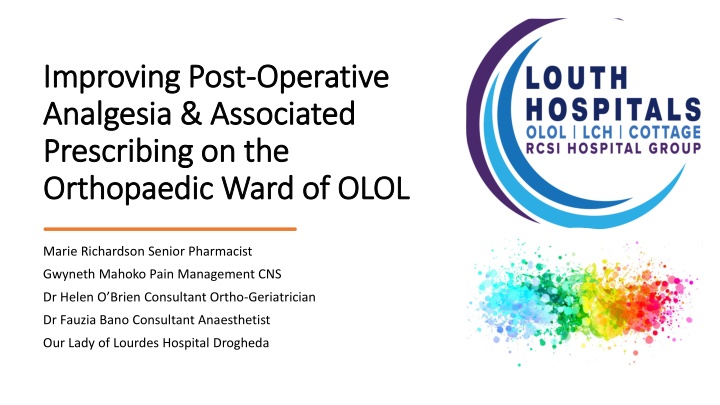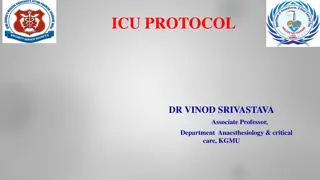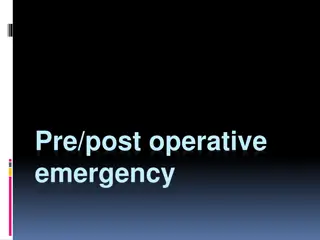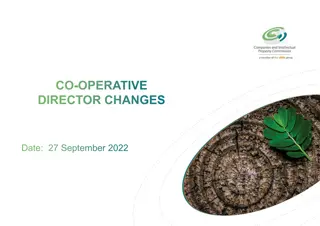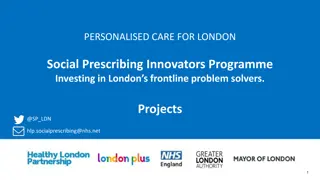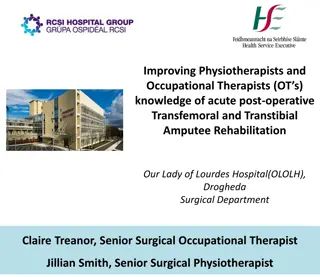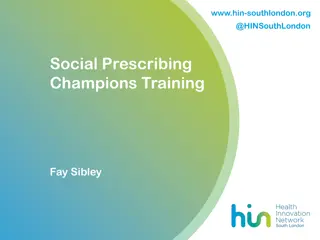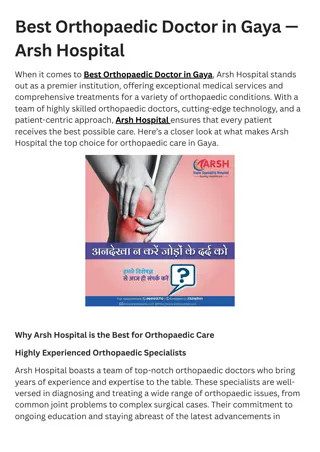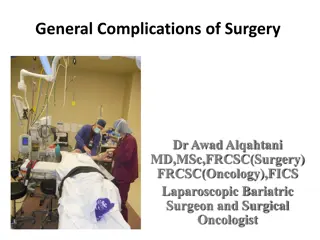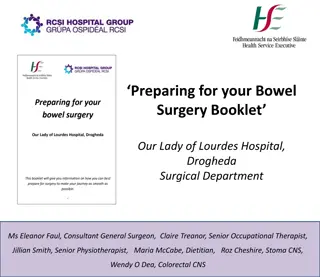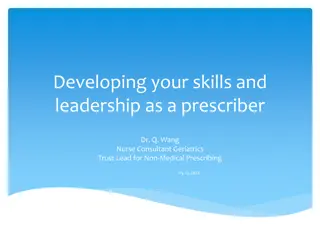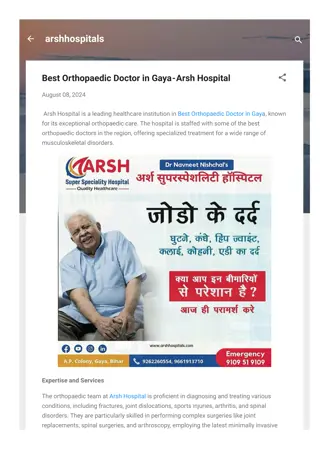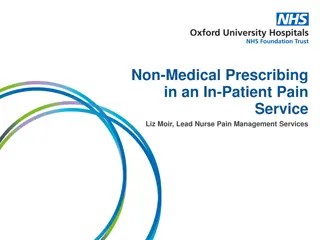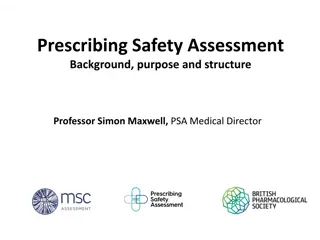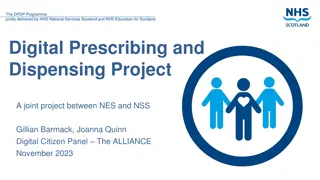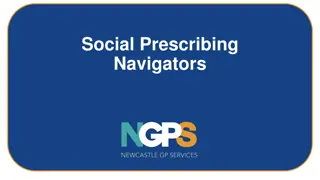Improving Post-Operative Analgesia & Associated Prescribing on Orthopaedic Ward
This project focuses on enhancing post-operative analgesia and associated prescribing practices on the Orthopaedic ward to improve patient recovery and quality of life. Key recommendations include avoiding routine use of slow-release opioids, limiting prescription duration, and ensuring proper disposal of opioid medications.
Download Presentation

Please find below an Image/Link to download the presentation.
The content on the website is provided AS IS for your information and personal use only. It may not be sold, licensed, or shared on other websites without obtaining consent from the author.If you encounter any issues during the download, it is possible that the publisher has removed the file from their server.
You are allowed to download the files provided on this website for personal or commercial use, subject to the condition that they are used lawfully. All files are the property of their respective owners.
The content on the website is provided AS IS for your information and personal use only. It may not be sold, licensed, or shared on other websites without obtaining consent from the author.
E N D
Presentation Transcript
Improving Post Improving Post- -Operative Analgesia & Associated Analgesia & Associated Prescribing on the Prescribing on the Orthopaedic Ward of OLOL Orthopaedic Ward of OLOL Operative Marie Richardson Senior Pharmacist Gwyneth Mahoko Pain Management CNS Dr Helen O Brien Consultant Ortho-Geriatrician Dr Fauzia Bano Consultant Anaesthetist Our Lady of Lourdes Hospital Drogheda
Psychological Impact Post Post- -Operative Operative Analgesia: Analgesia: Chronic Pain Depression Delirium Economic Cost Increased readmission incidence Increased length of stay Additional supports Significant Significant Impact on Impact on Patient Recovery Patient Recovery & Quality of Life & Quality of Life Reduced Mobility Cannot complete physiotherapy and rehabilitation Increased risk of thromboembolism and pneumonia Falls & Pressure Ulcers Reduced Sleep & Reduced Physical Function
Local Project Local Project Background Background Post-operative analgesia and associated prescribing for patients on the Orthopaedic ward Variation in practice No formal guidance for post operative prescribing in place until July 2022 Potential to affect patient care
Project Aims: Project Aims: Key Recommendations: 1. Slow-release opioids are not routinely recommended in this setting Opioid conversion table and analgesia pathway 2. Duration of (discharge) prescription of maximum 4 days prior to review 3. Appropriate disposal of opioid medications to prevent diversion and misuse Included in new Patient Information Leaflet
Documents developed with multidisciplinary input from: Ortho-Geriatrics Pharmacy Anaesthetics Pain Management CNS Dr Helen O Brien Marie Richardson Dr Fauzia Bano Gwyneth Mahoko Developed Documents: Development Development Post Operative Opioid Conversion Chart Orthopaedic Analgesia Prescribing Guideline Opioid Patient Information Leaflet Presented to and approved by the local Drugs & Therapeutics Committee (OLOL).
Post-Operative Opioid Conversion Chart
Analgesia Prescribing Guideline
Analgesia Prescribing Guideline
Opioid Opioid Post Post- -Operative Operative Patient Patient Information Information Leaflet Leaflet Patient satisfaction survey Pre and Post Introduction of Leaflet Completed Nov & Dec 2022
Proforma audit document developed based on Orthopaedic Analgesia Guideline Baseline Point Prevalence Audit completed 4th July 2022 How did we measure the change in practice? Review of: Point Prevalence Reaudit Kardex Medical notes ECG Laboratory results completed 15th November 2022
Results Baseline Audit July 4th 2022 Medicine Group No of Patients Prescribed % of Patients Prescribed No of Appropriate Prescriptions % of Appropriate Prescriptions No of Inappropriate Prescriptions % of Inappropriate Prescriptions Interventions Incidents Paracetamol 29 100% 27 93% 2 7% 2 2 4 14% 1 25% 3 3 2 NSAID s 75% 26 90% 24 77% 7 7 0 Opioids 23% 20 69% 28 68% 13 17 0 Laxatives 32% Gabapentenoids 2 7% 2 100% 0 0% 0 0 Antiemetics 19 66% 18 95% 1 5% 1 0
Recommendations from Baseline Audit Recommendations from Baseline Audit Only Short acting Opioids regular and PRN for patients 65 years Short duration opioid discharge prescriptions Opioids Prescribe regular laxatives to all patients prescribed opioids Lactulose to always be prescribed as regular Laxatives NSAID s Avoid NSAID s in patients 65 years
Action Plan Action Plan Meetings with Stakeholders Accessible Information Education Education sessions held on the ward Anaesthetics A2 posters for the Opioid Conversion table and the Analgesia Guideline were printed Orthopaedic Surgeons Available daily initially, then reduced frequency Presentation of July Audit results at Journal Clubs & Education Sessions Clinical Room Central Administration Area Local Electronic Database
Reaudit November 15th 2022 Medicine Group No of Patients Prescribed % of Patients Prescribed No of Appropriate Prescriptions % of Appropriate Prescriptions No of Inappropriate Prescriptions % of Inappropriate Prescriptions Interventions Incidents Paracetamol 26 (27 Rx s) 93% 20 74% 7 26% 7 1 6 21% 5 83% 1 2 0 NSAID s Opioids 17% 20% 26 (35 Rx s) 93% 28 80% 7 7 0 24 (54Rx s) 86% 40 74% 14 14 0 Laxatives 26% Gabapentenoids 7 25% 7 100% 0 0 0 0 Antiemetics 21 (36Rx s) 75% 33 91% 3 9% 3 0
Audit and Reaudit Demographic Audit and Reaudit Demographic 4th July 2022 15th November 2022 29 28 68 years 68 years 73kg 74kg Parameter: Number of Patients Mean Age Mean Weight Injury Type: Hip Related 41% 56%
Prescribing Analysis of Audit and Reaudit Parameter: July 2022 15% November 2022 0 No opioid na ve patients 65 years to be prescribed a long-acting opioid Patients 4 days post-op to be prescribed a regular and PRN short acting opioid All patients prescribed an opioid to be prescribed at least one regular laxative Lactulose to be charted as regular not PRN Avoid inappropriate NSAID s in patients 65 years old Paracetamol to be dose adjusted for weight 50kg and impaired hepatic function Anti-emetics to be prescribed taking into account of QTc and Parkinson s disease 65% 93% 73% 92% 75% 75% 93% 91% 17% 74% 95% 91%
How has the project evolved: Developed working relationship with Physiotherapy General Surgery Post-Operative Analgesia Guideline Developed Joint Research Joint Education Reaudit of patients from 2022 Development of Version 2 of Opioid Conversion Chart and Orthopaedic Mobility: 30% improvement in post- operative patient mobility Length of Stay: reduction in LOS for Hip related injuries Post-Operative Analgesia Prescribing Guideline
1. Ferris, H., Brent, L. and Coughlan, T. (2020) Early mobilisation reduces the risk of in-hospital mortality following hip fracture. European Geriatric Medicine, 11(4), pp. 527-533. 2. Ferris, H., Brent, L., Sorensen, J., Ahern, E. and Coughlan, T., 2021. Discharge destination after hip fracture: findings from the Irish hip fracture database. European geriatric medicine, pp.1-10. 3. National Office of Clinical Audit (2019) Irish Hip Fracture Database National Report 2018. Dublin: National Office of Clinical Audit. 4. National Office of Clinical Audit, (2021) COVID-19 report 2.0: Service impact from COVID-19: Analysis based on Irish Hip Fracture Database June 2019-August 2020. Dublin: National Office of Clinical Audit. 5. GUIDANCE FOR OPIOID PRESCRIBING FOR ACUTE NONCANCER PAIN, POSTOPERATIVE PAIN & POSTPROCEDURE PAIN HSE Jan 2022 https://msurgery.ie/wp-content/uploads/2022/02/Opioid-guidance-HSE-1.3-CDI-Final.pdf 6. Our Lady s Hospice Harold s Cross https://olh.ie/wpcontent/uploads/2019/01/Opioid-Conversion-Chart-2018.pdf 7. Renal Drug Database https://renaldrugdatabase.com/ References: 8. Pharmacological Management of Cancer Pain in Adults, National Clinical Effectiveness Committee Nov 2015 https://www.gov.ie/en/collection/eec97d-pharmacological-management-of-cancer-pain-in-adults/ 9. Mellar et al 92020)Tapering opioids: a comprehensive qualitative review http://apm.amegroups.com/article/view/34860/29324 10. WHO Analgesic Ladder Aabha A. Anekar; Marco Cascella. May 17, 2020. https://www.ncbi.nlm.nih.gov/books/NBK554435 / 11. Controlled-release opioids cause harm and should be avoided in management of postoperative pain in opioid na ve patients British Journal of Anaesthesia Editorial October 19, 2018 https://doi.org/10.1016/j.bja.2018.09.005 https://bjanaesthesia.org/article/S0007-0912(18)30711-6/abstrac t 12. Management of Post-operative Nausea and Vomiting (PONV) Greater Glasgow and Clyde(GGC) NHS Medicines Adult Therapeutics Handbook November 2020 https://handbook.ggcmedicines.org.uk/guidelines/pain-post-operative-nausea-and- vomiting-and-palliative-care-symptoms/management-of-postoperative-nausea-and-vomiting-ponv/ 13. Pathophysiology and management of opioid-induced constipation: European expert consensus statement by Adam D; Asbj rn M Drewes; Giuseppe Chiarioni; Roberto De Giorgio; Tony O Brien; Bart Morlion and Jan Tack. United European Gastroenterology Journal 2019, Vol. 7(1) 7 20 https://journals.sagepub.com/doi/pdf/10.1177/2050640618818305 14. Considerations for the inpatient management of Parkinson s disease The Pharmaceutical Journal 20 March 2020 By Maria Nawaz & Oyinkansola Close https://pharmaceutical-journal.com/article/ld/considerations-for-the-inpatient-management-of- parkinsons-disease
Better Better Analgesia Analgesia Prescribing Prescribing Leads to Leads to Better Better Patient Patient Outcomes Outcomes Thank You Questions
